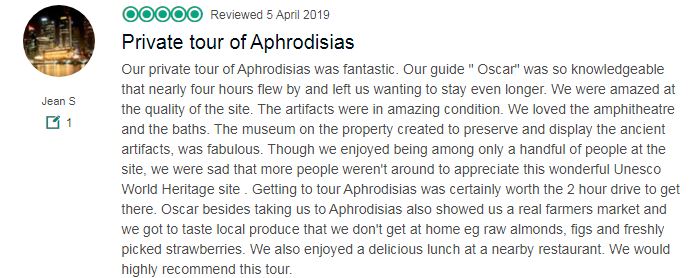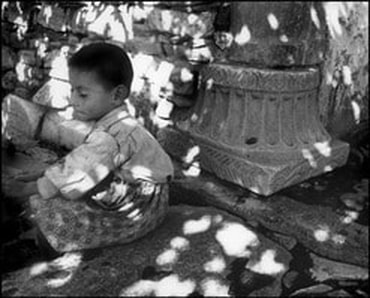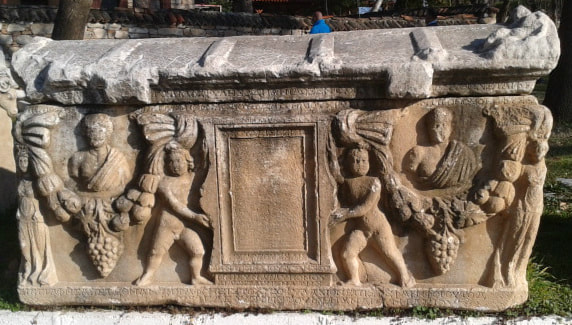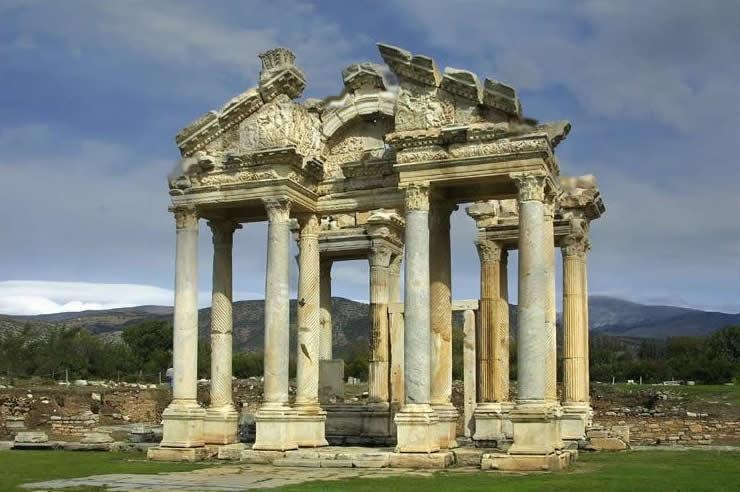Discover Ephesus and Top Destinations in Western Turkey with an expert tour guide and a TripAdvisor Winner for 13 consecutive years.
Private Aphrodisias Tours from Kusadasi and SelcukAphrodisias was the most famous ancient city that was named after the Goddess Aphrodite. The ancient city of Aphrodisias is one of the most important archaeological sites of modern Turkey. Discover the famous UNESCO world heritage sites of Turkey with a licensed knowledgeable tour guide. We offer Private Aprhodisias Tours from Kusadasi, Selcuk, Sirince Hotels and Kusadasi Port. Aphrodisias, is one of the top archaeological attractions of Western Turkey. You will be enchanted by the beauty of Aphrodisias. Where is Aphrodisias? Aphrodisias is located in southwestern Turkey, in the province of Aydin. It takes approximately 2.5 hours drive from Kusadasi to Aphrodisias. The distance between Kusadasi and Aphrodisias is 155km. There is no direct transportation from Kusadasi to Aphrodisias. Aphrodisias History Aphrodisias was a small Greek city in the province of Caria. The current ancient city is located nearby the village of Geyre. It takes approx. 2.5 hours drive (140 miles) from Kusadasi to reach Aphrodisias. Aphrodisias, unlike Ephesus has never been a port city. The city is 62 miles inland from the coast. Aphrodisias is 2000 feet above sea level and located by the 8000 feet mountain called Babadag (known as Salbakos in the ancient times). The city before adopting the name ''Aphrodisias'', it was named as Lelegeopolis, Megapolis and Ninoi. The name "Ninoi" is given by the Asyrians who settled this area. Ninoi is also the name of a city located in Asyria. Asyrians introduced Ishtar culture to the city. Probably, the words Star and Easter is derived from the goddess Ishtar. Aphrodisias, covers an area of 200 acres and generally is a flat city. Unlike many other ancient cities in Anatolia, Aphrodisias was discovered by a famous Turkish photographer Mr. Ara Guler in 1958. He was travelling through villages and towns. He was in the village of Geyre and noted a village that has so many ancient remains that the villagers live without knowing their importance. Afterwards Ara Guler was in touch with the Turkish Archaeologist Mr. Kenan Erim from New York University. Excavations began in the 1960s. Kenan Erim devoted his life to excavate this ancient city. Since this city is lately discovered, you do not see any remains from this city in British Museum or any other museums outside Turkey. Aphrodisias became an artistic center with a famous school of sculpture. The city was also famous with ceremonies made in Aphrodite Temple in the name of Aphrodite. Ruined because of the earthquakes. In the 4th and 7th century. Major earthquakes happened and changed the route of the rivers nearby. The City was under flood due to change of route of water. After 7th century earthquakes, the city lost its importance. In the 6th century. The name of Aphrodisias was changed to Stauroupolis, meaning the city of the Cross, to erase the pagan goddess of love from peoples minds. As the capital of Caria, Aphrodisias was finally called Caria which then became Geyre in Turkish. Later in the 13th century, the city was abandoned. Aphrodisias was founded near a marble quarry that was extensively used in the Hellenistic and Roman times. The closest quarry was half a mile away from Aphrodisias. The marble sculptures of Aphrodisias became very famous during the Roman period. Many examples have been excavated in Aphrodisias. The sculptors of Aphrodisias became famous and benefited from a great supply of quality marble nearby. There was a famous school of sculpture here which was very productive. A lot of sculpture can be seen today around the ancient city and in the museum. Many finished and unfinished statues discovered in the area. Unfinished statues prove the existence of a Sculpturing School. Many sarcophagi were excavated at several locations in site, frequently decorated with designs of garland, columns, figures of people, birds and animals. Names of many sculptors from Aphrodisias have been seen in lots of works in Italy, Greece and elsewhere. Excavations in the theater hill have revealed layers of settlement going back to the Bronze Age. Aphrodisias was founded in the 5800 BC and flourished under the Roman Empire. First settlers were Carians, Pelasgians and Lelegians. Aphrodisias is mentioned in the 1st century BC by geographer Strabo. Aphrodisias was named after Aphrodite, the goddess of love. Aphrodite was known to Romans as Venus. The name of the city has the same root as the word "aphrodisiac". Both words derive from the Greek name Aphrodite, the goddess of love, Aphrodisias was one of several ancient cities dedicated to the goddess of love. Within the borders of Caria, during the Roman period, following the assassination of Julius Caesar in 44 BC. The assassins, Brutus and Cassius fled to Asia Minor where they invaded many cities. Aphrodisias, remained loyal to Caesar. There is evidence that the city was attacked by the supporters of Cassius and Brutus. The main reason, keeping the city loyal to Caesar is because of Zoilos, the former slave of Caesar who was freed by Octavian. Mark Antony recognized the autonomy of Aphrodisias in the 1st century BC. Fame of Aphrodisias is not only limited to arts. It also had a number of renowned scholars and writers as well as philosophers, of whom the most notable ones were Xenocrates and Alexander of Aphrodisias. Alexander was a famous philosopher from Aphrodisias. He followed the teachings of Aristotle. Born in Aphrodisias and lived and taught in Athens at the beginning of the 3rd century, where he held a position as head of the Peripatetic school that is founded by Aristotle. He wrote many commentaries on the works of Aristotle (Aristotle, was a Greek philosopher who lived in the 4th century BC. One of the students of Plato and tutor of Alexander the Great.) Statues were carved from the local white, grayish blue Carian marble, mostly from Babadag (Salbakos), nearby mountain. Sculptors from other areas came to Aphrodisias for annual sculpture competitions. The eyes of the statues found here are full of expression and vitality and the bodies seem capable of moving. The public monuments in Aphrodisias were decorated with "peopled scrolls" which were one of the characteristics of stone carving produced by the school of sculpture in Aphrodisias. Some masterpieces have the signatures of their creators who are especially experts in relief and sarcophagus production. Many sarcophagi were decorated with lively reliefs, symbolizing the desire to deny the emptiness of death and its eternal darkness. These sculptors imposed their creative mastery over iron and marble. Iron tools and instruments were to achieve victory and greatness not only in battle fields but in the field of sculpture as well. Anatolia was in a period when matchless works of sculpture were created. The old traditions of Anatolian sculpture reached a phase of lively fineness and beauty of expression. Aphrodisias was a special city and beloved by Augustus. Due to this it was exempted from paying taxes. There could be several reasons for this:
In a letter written by Emperor Augustus to Stephanus (governor of Laodicea), Aphoridisias is privileged: ''Caesar to Stephanus With the tax-free status Aphrodisias became a popular pilgrimage destination. Starting from 1st century BC, in Aphrodisias, a long period of prosperity began. The city gained a reputation of being an artistic, cultural center and as well as a center for religious activity. Many important writers and philosophers like Alexander of Aphrodisias lived in this city. Tetrapylon was a monumental gateway that leaded entrance to the Temple of Aphrodite. The gateway was built in the late 2nd century AD during the reign of Hadrian. It had 4 rows of 4 columns. It is thought to have marked the intersection of a major street with a sacred way heading toward the sanctuary of Aphrodite. The Temple of Aphrodite was the main attraction of the Ancient City of Aphrodisias. Historians think that before this temple was built here, there was an earlier cult for Mesopotamian goddess Ishtar who is known as goddess of fertility and sex. There were festivals in the name Ishtar at the beginning of spring. These celebrations are made for the arrival of spring in the name of Ishtar. The name Ishtar is also associated with the word Easter. The building was converted into a church during the Byzantine period. From this church, historians mention twenty bishops from Aphrodisias who attended the ecumenical councils in the early times of Christianity. The building was originally designed as an Ionic temple with 40 columns arranged in an 8 by 13 rectangle shape. Once it was converted into a church, the columns at each end were removed, an apse was built in the eastern section, and a baptistery and an atrium were added to the west. On some columns donor names are being noted. Life in the city was concentrated on the Temple of Aphrodite. The cult of Aphrodite was so popular that it took some time before Christianity was fully accepted by Aphrodisians. The temple was founded here in the 1st century BC with the funding made by Zoilos. Worship to Aphrodite goes back to 7th century BC to Assyrians who came here from Mesopotamia and settled here and worshiped to a goddess named as Ishtar who is also the goddess of love. The similarities between Aphrodite and Ishtar are generally well-recognized. In Mesopotamian mythology, Ishtar was the principal goddess of the Babylonians and Assyrians. She was both the compassionate mother of all life, who brought fertility and relief from sickness, and the lustful goddess of sexual love and war. Stadium of Aphrodisias, is one of the best preserved stadium in Anatolia with a 30,000 spectator capacity. Originally it had a blind arcade on top of the highest row surrounding all the seats. The stadium was used for gladiatorial fights, chariot races, sporting, musical and dramatic events. The eastern part of the arena was for gladiatorial fights. This is a hybrid structure, a mixture of a Greek stadium and a Roman Arena. Therefore, it was used for sport events, executions and gladiatorial fights. Reserved seat carvings on seats can still be noticed at the seats of the stadium. Women were not attending athletic events since all the men was competing nude. The Stadium was double size of the population of Aphrodisias. Probably, a smaller type of Olympic Games in the name of Aphrodite was held here. Bouleuterion (senate house), is located at the north side of the North Agora. The original building was vaulted. Seating capacity is expected to be about 1750. Archaeologists found many unfinished statue pieces and sculpturing tools during the excavations done in the area between Bouleterion and Aphrodite temple. For this reason the place is considered as the famous sculpture school of Aphrodite in archaic ages. The school was actively used from 1st century BC until 6th century AD, Some historians believe that there were some sculpturing artists moved to the city from Pergamon after the death of Attalus 3rd who inherited his empire and treasure to the Roman Empire in the second century BC. The artists who were left without work moved to Aphrodisias. The reputation of the artists of Aphrodisias was beyond Anatolia and Rome. Baths of Hadrian were built under Hadrian in the 2C AD. Hadrian visited the city of Aphrodisias and these roman baths were constructed in the memory of his visit. There were two pairs of large rooms on either side of a huge central hall called the caldarium. Total 4 sections as Apodyterium (Chaging rooms), Fridgiderium (Cold Rooms), Tepiderium (Luke warm/tepid room) and Caldarium (Hot/Steam Room). During the excavations in the villa of Hadrian in Tivoli, Italy. Archeologists discovered many statues made in Aphrodisas. South Agora also known as the Portico of Tiberius, had an Ionic colonnade which has partially been restored, was started during the reign of Tiberius, 1st century AD. The central area of the portico is occupied by a huge basin or pool, with two semicircular extremities at the north and east ends. The portico may well have been a gymnasium or a palaestra with an exercise area between the colonnade and the pool. North Agora, was mainly used for commercial reasons. This was the marketplace. In the middle of North Agora. The Monumental Tomb of Zoilos was located. Theater was built in the late Hellenistic period and later restored in the 1st century BC, and according to its inscription it was dedicated to Aphrodite and the people of the city by Gaius Julius Zoilos, a former slave of Gaius Julius Caesar and later on inherited to Octavian. Octavian gave freedom to Zoilos. The seating capacity was 8,000. The stage building consisted of six vaulted dressing or storage rooms out of which four opened into the corridor behind the proskene. The stage building wall in the north parados had Greek inscriptions of important documents related to the history of the city such as letters of emperors to the city or senatorial decrees. The orchestra and the stage building were restored in the 2nd century AD in order to make the building more suitable for animal or gladiatorial fights. The theater was seriously damaged in the 7th century, and the Byzantines built houses on top of the cavea and converted the hill into a fortress by circling it with walls and towers. In the excavations an inscription is found saying that Julius Galius Caesar gifted a Golden Eros statue to Aphrodite. The statue is later stolen from the city and taken to the Temple of Artemis in Ephesus. From the inscription it is thought that Caesar was in the city of Aphrodisias. The levelled seat rows show that there were gladiatorial games played in the theater. Tetrastoon, originally surrounded by four (tetra) colonnades on all sides with a round fountain in the center, had several functions in the Roman and Byzantine city. First it was a meeting place for the citizens and also by having surrounding small shops served as a marketplace. Finally, it gave access to the theater. To the south of the tetrastoon was the Imperial Hall with theater baths which have not been completely excavated. Sebasteion, was a early 1st century AD shrine in which the emperor was worshiped. The building was built after the death of Zoilos in 20 AD, to have good relations with Rome the capital. Sebasteion derived from the Ancient Greek word "Sebastos", which is the Greek equivalent of "Augustus". The structure had 3 stories. Each story was decorated with three different column orders, Doric, Ionic and Corinthian. The building was first unearthed in 1979 it appeared to have no relation to any other building but, as excavations were carried down to deeper levels, it became apparent that this consisted of a temple dedicated to the cult of the Emperor Augustus (Sebastos is the Greek equivalent of the Latin Augustus). Excavations yielded a quite extraordinary quantity of reliefs and decorative panels. Second story display famous stories from the Greek Mythology. Third story the success stories of Julius Caesar and his dynasty. The most remarkable of these included depictions of the birth of Eros, the Three Graces, Apollo in Delphi, Meleager, Achilles and Penthesilea, Nyssa and the child Dionysus. There are also reliefs of some members of the imperial family and mythological figures. Those identified include Augustus, Germanicus, Lucius, Gaius Caesar, Claudius and Agrippa, together with Prometheus and Aeneas fleeing from Troy. There is also a fascinating group of reliefs symbolizing Claudius's conquest of Britain and Nero's conquest of Armenia. There are also a number of fragments depicting the peoples of the various countries with which Augustus had waged war or formed other types of relationships but these have suffered severe earthquake damage. The longest Jewish inscription from the Classical world was also discovered by the Archaeolgists in Aphrodisias. The inscription written on a pillar is dating back to 3rd century AD and describing 126 donors. Probably the donors of a synagogue in Aphrodisias. According to the inscription excavated in Aphrodisias we know there was major Jewish community living in the city and descriptions of the synagogue. In the inscriptions names of the Jews, the people who have sympathy to Jews and their occupations were noted. 54 of the donors were named as Theosebeis. People who had sympathy to Jews were named as 'Theosebeis' meaning Godfearers. Theosebeis people were gentiles who had sympathy to Jews and Judaism but did not change their pagan faith. Aphrodisias was, in ancient terms, a medium-sized town (90 hectares, with a population of maybe 15,000-20.000 inhabitants), but one with a typically metropolitan grandeur of architectural design. The monuments and marble sculptures show a distinctive period of ancient city life. The most prosperous days of Aphrodisias was between 1st century BC and 2nd century AD. The city lost its tax-free status after 3rd century AD due to administrative and political changes. We offer private Aphrodisias tours from Kusadasi, Sirince and Selcuk.Cost of Private Aphrodisias Tour from Kusadasi:
Mercedes V-Class (1-6 people) + English Speaking Tour Guide: 280 Euro (For groups over 6 people, please contact us for the cost.) * Above rate is not a per person rate, it is per group. Rates Cover: - Services of an excellent English speaking Guide - A/C MPV - All transportation costs. - Tax, service charges - Parking fees Rates Do Not Cover: - Entrance to the sites. (Cost of Entrance Fee: 140 Turkish LIras = 6.5 Euro per person) If requested a day tour of Aphrodisias tour can be combined with Pamukkale (Hierapolis). We offer 2 and 3 days private tours of Ephesus, Aphrodisias, Pamukkale and more: 2 Days Western Turkey Tour - Ephesus, Pamukkale, Aphrodisias... 3 Days West Turkey Tour - Pergamon, Ephesus, Pamukkale, Aphrodisias... For more information please contact us.
6 Comments
|
Ephesus Travel Guideby TransBalkan Tours is a fully licenced tour operator since 1963 and a member of TURSAB. Ephesus Tour from Kusadasi Port
Ephesus Tour from Izmir Ephesus Tour from Selcuk Ephesus Tour Guide Kusadasi Airport Transfer Kusadasi Pamukkale Tour Ephesus Biblical Tour Istanbul Ephesus Tour Ephesus Guided Tour Ephesus Shore Excursions Efes Tur Rehberi Ephesus Walking Tour 7 Churches Tour Turkey Categories
All
Archives
July 2024
|














 RSS Feed
RSS Feed
